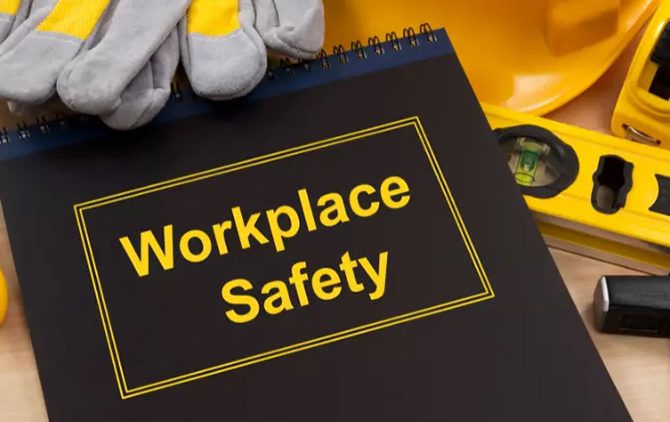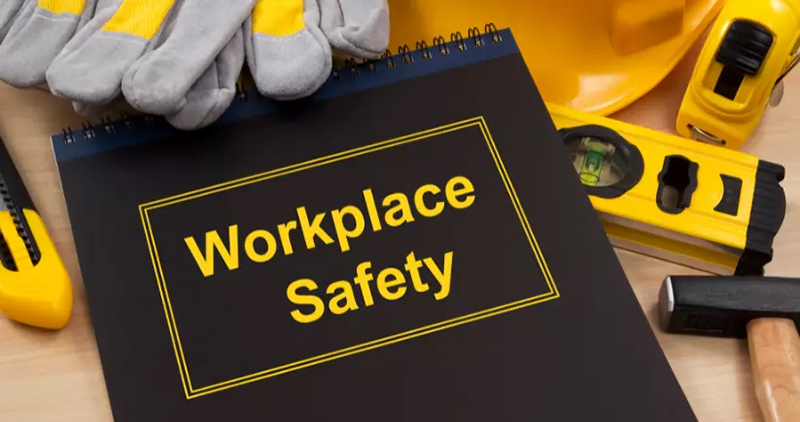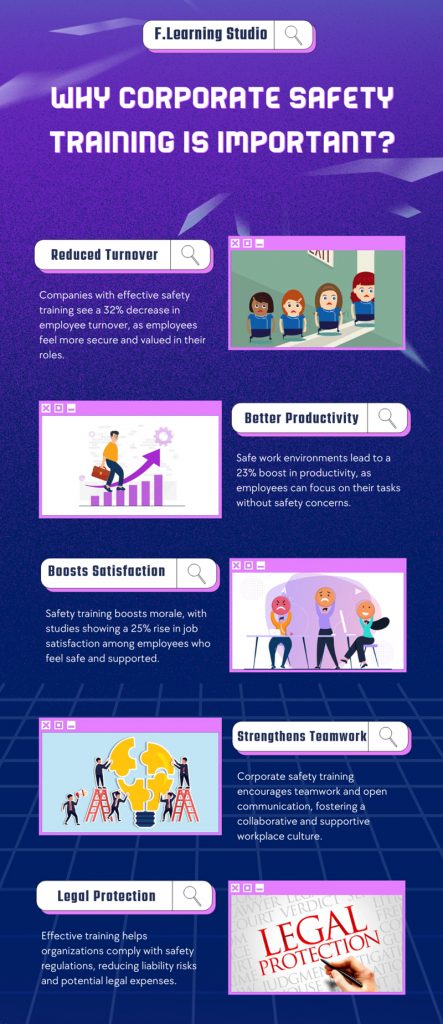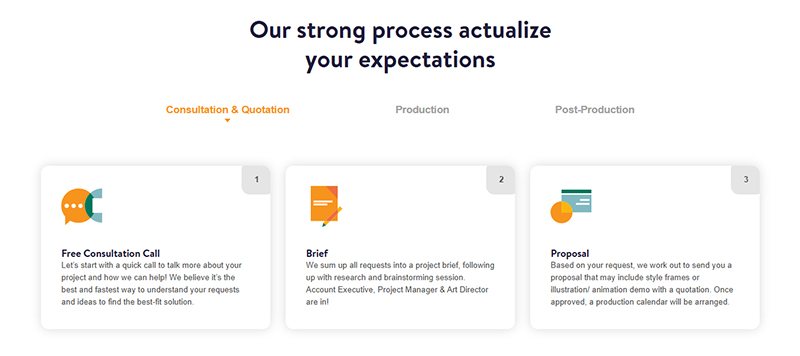- What is the Workplace Safety Training Program?
- Why Corporate Safety Training is Important
- 18 Popular Topics to Cover for Employee Safety Training Programs
- 6 Real-Life Corporate Safety Training Videos to Inspire Your Team
- TOP 6 Best Practices for Delivering Effective Corporate Health and Safety Training
- 1. Comprehensively Assess Training Needs
- 2. Tailor Training Content to Specific Hazards
- 3. Incorporate Interactive Learning for Better Engagement
- 4. Offer Regular Refreshers to Help Employees Retain Safety Knowledge
- 5. Leverage Expertise from Experienced Trainers
- 6. Continuously Measure Training Effectiveness
- TOP 9 Courses for Employee Safety Training Programs in 2024
- At F.Learning Studio – We Know How to Create Employee Safety Training Programs that Work
- Conclusion
What is the Workplace Safety Training Program?
Why Corporate Safety Training is Important
18 Popular Topics to Cover for Employee Safety Training Programs
6 Real-Life Corporate Safety Training Videos to Inspire Your Team
1. Danger Zone at the Office
This video showcases common office hazards and how employees can avoid them. Through relatable scenarios, it demonstrates the importance of maintaining a safe workspace and being aware of potential dangers in everyday office tasks. It’s a great example of how to address workplace safety in a simple, easy-to-understand format.
2. How to Use a Fire Extinguisher
This instructional video provides a step-by-step guide on using a fire extinguisher effectively. It breaks down the process clearly, ensuring that employees can respond swiftly in the event of a fire emergency. This vital safety skill can also be integrated into online training courses for easy access and repetition.
3. Bloodborne Pathogens Training
In this video, employees learn about bloodborne pathogens, the risks they pose, and the precautions necessary to prevent exposure. It provides a detailed look at the correct procedures for handling potentially infectious materials in the workplace, emphasizing safety protocols that can be incorporated into any safety program.
4. Driver Tiredness, Fatigue and Road Safety
Focusing on the dangers of driver fatigue, this video educates employees about the risks associated with tired driving and offers tips on staying alert on the road. It’s a crucial resource for businesses with employees who drive as part of their job, ensuring that road safety is a priority in all training programs.
5. Industrial Safety Video
This explainer video is part of Aviassist’s comprehensive drone training session, focusing on the critical no-fly zones around airports. It clearly illustrates where drones are not allowed to operate due to safety regulations, emphasizing the importance of following these restrictions to avoid accidents and legal issues. This video is an excellent resource for training drone operators and can be effectively incorporated into online training programs for easy, accessible learning.
If this video matches your style, give F.Learning Studio a call so that we can discuss more about your needs:
interested to know more?
Glad you like us! Book a consultation call with us to explore how to kick start your animation project.
6. Lockout Tagout Machinery Safety Animation
This animated video teaches the lockout/tagout safety procedures, which are essential for workers who operate or maintain machinery. It uses clear animations to demonstrate how to safely deactivate machines during maintenance, a crucial skill for preventing workplace injuries. This content can easily be adapted into online training for effective remote learning.
TOP 6 Best Practices for Delivering Effective Corporate Health and Safety Training
To ensure the success of your corporate health and safety program, it’s important to adopt best practices that not only meet regulatory requirements but also promote employee health and well-being. These strategies help create a safer work environment and engage employees in maintaining safety standards.
1. Comprehensively Assess Training Needs
Description: Start by identifying specific health and safety challenges within your organization to ensure the training is relevant and impactful.
How to Do:
- Conduct a risk assessment to identify potential hazards.
- Survey employees to understand their awareness and concerns.
- Consult with department heads to gather insights on safety needs in their areas.
- Review past incidents to highlight areas needing improvement.
Benefit: Ensures training addresses real risks, increasing engagement and making the training more valuable and effective.

2. Tailor Training Content to Specific Hazards
Description: Tailor the training content to suit the unique needs of your workforce, job roles, and the specific risks associated with different departments.
How to Do:
- Segment employees based on their roles and responsibilities.
- Develop targeted modules for different departments, such as office ergonomics for administrative staff and machinery safety for factory workers.
- Include case studies and examples relevant to your industry.
Benefit: Increases relevance, making employees more likely to retain the information and apply it in their roles.

3. Incorporate Interactive Learning for Better Engagement
Description: Use interactive elements like quizzes, simulations, and hands-on exercises to make the training more engaging.
How to Do:
- Include quizzes after each module to reinforce learning.
- Set up virtual or physical simulations to practice skills like fire extinguisher use or first aid.
- Encourage group activities and discussions to share insights and problem-solving approaches.
Benefit: Enhances retention by allowing employees to actively participate in their learning, making it more enjoyable and memorable.

4. Offer Regular Refreshers to Help Employees Retain Safety Knowledge
Description: Health and safety knowledge needs regular updates, especially as procedures, policies, and potential hazards change over time.
How to Do:
- Set a schedule for annual or semi-annual refresher sessions.
- Update training content with the latest regulatory changes and company policy updates.
- Offer shorter, focused refresher modules rather than lengthy sessions.
Benefit: Keeps employees’ knowledge up-to-date, ensuring they remain prepared to handle new and existing risks effectively.

5. Leverage Expertise from Experienced Trainers
Description: Qualified trainers with practical experience in health and safety provide more credibility and can address questions more effectively.
How to Do:
- Hire certified health and safety professionals or partner with reputable training providers.
- Ensure trainers have hands-on experience relevant to the topics they teach.
- Encourage trainers to share real-life examples and case studies.
Benefit: Boosts training credibility, as employees are more likely to trust and learn from knowledgeable trainers.
6. Continuously Measure Training Effectiveness
Description: Track and assess the impact of the training program to identify areas for improvement and ensure it’s meeting organizational goals.
How to Do:
- Use pre- and post-training assessments to gauge knowledge improvement.
- Gather employee feedback through surveys or follow-up meetings.
- Monitor incident reports and safety metrics to observe any changes in safety outcomes.
Benefit: Provides valuable insights into training effectiveness, allowing for continuous improvement and increased safety across the organization.
TOP 9 Courses for Employee Safety Training Programs in 2024
As employee safety becomes a top priority, selecting the right online training courses is crucial for fostering a secure workplace and helping businesses ensure their teams are well-equipped to handle workplace risks.
| No. | Course Name | Format | Provider | Key Topics | Best For |
| 1 | Certified Safety Manager (CSM) | Online | National Association of Safety Professionals (NASP) | Risk management, hazard identification, accident investigation | Managers, safety professionals |
| 2 | First Aid, CPR, and AED | In-person | American Red Cross | Emergency response, CPR, automated external defibrillator (AED) use | General employees, first responders |
| 3 | Fire Protection Specialist | Online | National Fire Protection Association (NFPA) | Fire prevention, fire extinguisher use, evacuation protocols | All employees, emergency personnel |
| 4 | Hazard Communication | Online | 360training | Hazard communication standards, handling hazardous substances | Chemical handlers, lab workers, general employees |
| 5 | Lockout/Tagout (LOTO) Training | Online and In-person | JJ Keller | Lockout/tagout procedures, equipment maintenance, electrical safety | Maintenance staff, equipment operators |
| 6 | Electrical Safety for Non-Electricians | Online | National Safety Council | Electrical hazards, safety protocols, basic electrical practices | General employees, maintenance workers |
| 7 | Slips, Trips, and Falls Prevention | Online | eSafety | Fall hazards, prevention strategies, ergonomic best practices | General employees, facility managers |
| 8 | Construction Safety | Online and In-person | OSHA | Construction hazards, PPE, fall protection, equipment safety | Construction workers, site supervisors |
| 9 | Ergonomics in the Workplace | Online | Udemy | Ergonomics, injury prevention, workstation setup | Office workers, HR managers, facility managers |
While off-the-shelf courses can be a convenient option, they often lack the customization needed to address the specific safety challenges of your organization. These generic programs may not fully engage employees or cover all the unique risks of your workplace.
To create truly effective training, it’s recommended to collaborate with a professional studio. By customizing your safety training programs, you can ensure that the content is relevant, engaging, and tailored to meet the specific needs of your workforce, leading to better outcomes and a safer environment.

At F.Learning Studio – We Know How to Create Employee Safety Training Programs that Work
We Tailor Content that High Impact for Effective Safety Training
At F.Learning Studio, we understand that traditional safety training programs can often be overwhelming due to the sheer volume of information and the complexity of the content. Employees may struggle to absorb and retain important safety knowledge when it’s presented in long, dense formats. That’s why we specialize in breaking down safety training into manageable, bite-sized chunks that are easier to digest and remember.
By using engaging formats like scenario-based video animations and comic-style visuals, we transform complex safety concepts into clear, relatable, and memorable learning experiences. Our goal is to not only ensure compliance but also to foster a proactive safety culture, empowering employees to apply what they’ve learned effectively in real-world situations.
We Create Interactive Learning Experiences in Safety Training
Engagement is key for effective safety training, especially with the often dry and technical nature of the content. At F.Learning Studio, we understand that employees tend to be passive learners when the material isn’t tailored to their specific needs.
Workplace safety challenges – such as inconsistent safety practices, employee complacency, or the complexity of safety procedures – can make training even more difficult. That’s why we customize our interactive training to directly address these issues and relate to your workplace’s specific safety risks.
Whether it’s fire safety, equipment handling, or emergency protocols, we design scenario-based simulations, quizzes, and interactive exercises tailored to each safety topic. This approach encourages employees to actively engage with the material, helping them understand and retain critical safety knowledge.
Ultimately, our customized, interactive corporate training keeps employees focused, improves retention, and enhances their ability to apply safety practices in real-world situations.
We Provide a Streamlined Process that Minimizes the Cost
We know that developing effective safety training programs for employees doesn’t have to come with a hefty price tag. At F.Learning Studio, our streamlined process ensures that you receive a high-quality, customized safety training program at a cost-effective price. With our efficient approach, we help you minimize costs without compromising on the quality and effectiveness of your training, making us a “perfect match” for your employee safety training needs.
Conclusion
In conclusion, employee safety training programs are essential for creating a secure and productive workplace. Whether through customized courses, interactive learning, or cost-effective solutions, the right safety training program can have a lasting impact on both employee well-being and organizational success.
At F.Learning Studio, we understand the unique safety challenges your workplace faces, and we design training programs that ensure employees not only understand safety protocols but can also apply them effectively in real-world situations. Our focus is on delivering training that empowers your workforce to act confidently and safely, improving both their performance and the safety culture of your organization.
Contact us today to discuss how we can create a tailored safety training program that enhances your team’s skills and keeps them safe on the job!
- Email: [email protected]
- Fanpage: https://www.facebook.com/f.learningstudio
- Website: https://flearningstudio.com/
- LinkedIn: https://www.linkedin.com/company/f-learning-studio/

Sean Bui, the founder and creative director of F.Learning Studio, is a respected leader in the e-learning and multimedia production industry. With over 10 years of experience, he has dedicated his career to helping organizations create engaging and impactful learning experiences.
Under his leadership, F.Learning Studio has grown into a trusted partner for organizations in the education, healthcare, and corporate training sectors, producing over 2,000 minutes of educational animation.












